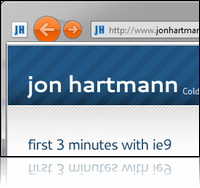jsFiddle Example: Recursive AngularJS Templates
- July 14, 2014 8:18 AM
- Templating, AngularJS, Examples & Tutorials, Javascript
- Comments (0)
This is a variation on a previous example, but I was recently asked how to generate HTML for tested items with AngularJS. This process is simple: create a fragment that represents the repeating element and then use ng-include and careful reference naming to create the recursion.


 I've been curious for a while about techniques for font replacement on the web. We've probably all heard about the idea of embedding fonts, but looking around at the standards right now, it doesn't sound like any one browser has things right, so I decided to explore a third-party option. Read more to learn about the basics of Cufon, an easy to use font "embedding" system.
I've been curious for a while about techniques for font replacement on the web. We've probably all heard about the idea of embedding fonts, but looking around at the standards right now, it doesn't sound like any one browser has things right, so I decided to explore a third-party option. Read more to learn about the basics of Cufon, an easy to use font "embedding" system.